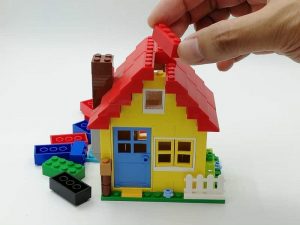Metaverse: The Real Future of the Virtual World

The emergence of the digital economy is a complex and ongoing process that has evolved over several decades. Today, collaborating the real world with a virtual one delivers new technologies at a breakneck progression. One such nascent yet most talked about technology of today is the Metaverse.
What is the Metaverse?
A platform where users can interact with each other through customizable avatars in various virtual spaces, where users can digitally create, own, and monetize their gaming experiences and assets, or where users can buy, develop, and sell parcels of digital real estate can be referred to as Metaverse.
To elaborate, the Metaverse can be thought of as an emerging 3D-enabled virtual universe that exists parallel to our physical world, typically through the use of virtual reality, augmented reality, and other advanced internet and hardware technology so that people can have lifelike personal and business experiences online with more control because of its decentralized nature.
History
In the early 1990s, when the internet started to commercialize with the evolution of web browsers and e-commerce services, sci-fi writer Neal Stephenson coined the term ‘Metaverse’ in his 1992 novel “Snow Crash.” describing a 3D virtual world that people could, in a sense, occupy.
In recent years, the concept of the Metaverse has gained significant attention due to advancements in technology and the growth of virtual and augmented reality, which paved the way for digital gaming. The virtual gaming environment allows players to interact with each other in the form of avatars, which inspired the idea of the Metaverse.
Today, the motivation behind the Metaverse is far beyond gaming after realizing the huge market potential of companies such as Microsoft, Google, Roblox, Shopify, JP Morgan, Nike, Adidas, McDonald’s, etc. The booming potential of Metaverse led Facebook’s CEO, Mark Zuckerburg, to change the name of his company, Facebook, to Meta in 2021.
Features
The features of Metaverse can vary depending on the specific platform or system, but some standard features and characteristics include:
- Immersive Virtual Worlds: Metaverses typically offer immersive 3D virtual environments where users can interact with each other and digital objects. These environments may resemble real-world spaces, fantastical settings, or entirely unique creations.
- Persistence: Unlike traditional online games or virtual worlds, Metaverses are often designed to be persistent, meaning they continue to exist and evolve even when users are not logged in. Others can see changes one user makes, and the Metaverse retains a history.
- Interconnectivity: Metaverses aim to be highly interconnected, allowing users to move seamlessly between virtual spaces and applications. Users can carry their avatars and possessions from one part of the Metaverse to another.
- User-Created Content: Many Metaverses enable users to create and contribute content, from virtual buildings and items to digital art and experiences. User-generated content often plays a significant role in shaping the Metaverse.
- Avatars: Users typically have avatars that represent them in the Metaverse, allowing for personal expression and interaction with other users.
- Social Interaction: Socialization is a core feature of Metaverse. Users can communicate with others via text, voice, or video, and they often participate in activities like virtual events, meetings, and parties.
- Digital Economy: Metaverses often have their own digital economies, where users can buy, sell, and trade virtual assets, including virtual land, clothing, and in-game items. Cryptocurrencies and blockchain technology may be used for transactions.
- Cross-Platform Accessibility: Metaverse aims to be accessible across various devices and platforms, including VR headsets, mobile devices, and traditional computers, to allow users to connect regardless of their hardware.
- Decentralization: Some Metaverses are built on decentralized technologies like blockchain to enhance virtual asset security, ownership, and control.
- Real-World Integration: Metaverse can blend with the physical world through augmented reality, enabling users to interact with digital elements in their physical surroundings.
- Gaming and Entertainment: Many Metaverses include elements of gaming and entertainment, such as quests, puzzles, or virtual events, to engage users.
- Personalization: Users can often customize their virtual spaces, avatars, and experiences to suit their preferences.
Technological Components
The Metaverse incorporates a wide range of technological components. These components work together to create immersive, interconnected virtual environments. Here are some of the key technological components of the Metaverse:
- Artificial Intelligence: Artificial Intelligence (AI) plays a significant role in developing and operating the Metaverse. It enhances the user experience, enables automation, and contributes to the functionality and realism of virtual environments. AI technologies like machine learning, computer vision, and natural language processing are instrumental in creating the sense of realism, responsiveness, and interactivity that make the Metaverse an engaging and dynamic virtual world. Key roles include content generation, voice and speech recognition, behavior prediction, creating realistic NPCs (Non-Playable Characters, which are lifelike characters and entities), safety and moderation, natural language processing (NLP), navigation and pathfinding, etc.
- Virtual reality: Virtual reality (VR) is a fundamental component of the Metaverse, as it enables users to immerse themselves in digital environments and interact with others more effectively. While not all aspects of the Metaverse require VR, it significantly enriches the user experience. It is expected to be a core component of many Metaverse experiences, such as interacting with friends and strangers in virtual spaces using avatars, playing spatial audio, hand and gesture tracking, therapeutic and wellness applications, architecture, design, gaming, entertainment, collaborative work, and training, etc.
- Augmented reality: Augmented reality blends a person’s view of reality with a virtual or digital image. Hence, AR enriches the Metaverse by bridging the gap between the virtual and physical worlds, providing users with new ways to interact, learn, play, and conduct everyday activities. AR allows users to overlay digital information and objects onto the physical world, enhancing how they interact with and perceive their natural surroundings. This can include adding virtual signs, labels, or information to physical objects or locations. Using AR devices such as AR glasses, users can gain a better sense of spatial awareness in the Metaverse. They can see their real-world environment while accessing virtual information, which can improve safety and usability. Digital twinning, training, education, navigation, healthcare, product visualization, and creative marketing campaigns are the areas in Metaverse where AR can complement VR in the Metaverse.
- Internet of Things (IoT): IoT is a system that adds a layer of real-world data and interconnectivity to the virtual and augmented realities in the Metaverse. It connects everything in the physical world to the Internet via sensors and gadgets, so these devices shall have a unique identification and the capacity to receive and send data automatically. This data can include environmental information, location data, biometric data, etc., enhancing the virtual environment’s realism and interactivity.
IoT can enable users to interact with and manipulate the physical environment through the Metaverse. For instance, users can control lighting, temperature, and security systems in their physical surroundings using virtual interfaces in the Metaverse.
IoT can create digital twins or representations of real-world objects and assets within the Metaverse. For example, a smart building can be replicated in the Metaverse, allowing users to interact with its virtual counterpart and access real-time information about the building’s systems.
Developing smart homes and cities, health and wellness monitoring, providing enhanced shopping experience, real-time weather monitoring-based virtual tourism, and controlling social and environmental interactions using virtual interfaces are some of the critical roles of IoT in the Metaverse environment.
- Blockchain technology: Blockchain can add up another security, transparency, and trust overlay in decentralized virtual environments. It can establish and verify ownership of digital assets within the Metaverse. Using blockchain-based tokens, users can have verifiable ownership of virtual land, virtual goods, in-game items, and digital art. For example, the cryptocurrency can be used to buy digital lands in Decentraland.
Blockchain can facilitate interoperability between different virtual worlds and platforms within the Metaverse. Users can move their assets and identity seamlessly within the same Metaverse or across various Metaverse environments using cryptocurrencies while working and socializing in the 3D digital environment.
The decentralized and secure nature of blockchain is well-suited for the Metaverse, as it addresses many of the challenges related to ownership, trust, and interoperability in virtual worlds. As the Metaverse continues evolving, blockchain will likely play an increasingly integral role in shaping its economy and infrastructure.
- Edge Computing: The Metaverse relies on real-time interactions between users and their virtual environments and interactions with other users. Edge computing, along with a 5G network, enables responsive, interactive, and synchronized experiences, allowing users to interact with virtual objects, communicate with others, and participate in events in real-time.
Edge computing brings computational resources closer to end-users, reducing the latency between user actions and server responses. It also enables distributed processing of Metaverse environments. Some computational tasks can be offloaded to edge nodes, reducing the burden on central servers and enabling efficient rendering of 3D graphics, simulations, and complex virtual scenarios while maintaining user privacy. This low-latency environment is essential for immersive Metaverse experiences, where slight delays can disrupt the sense of presence and real-time interactions.
Current Status
The huge market potential of the Metaverse has spiked up in 2023, which has motivated many companies like Microsoft, Google, and Nvidia to develop their own Metaverse. Currently, many Metaverse applications are available for use.
- Decentraland is the first online decentralized social platform and is booming rapidly. It features smart contracts, allowing users to trade their land, apparel, characters, etc digitally.
- Another popular Metaverse is Sandbox, which is analogous to Decentraland. Both have similar DAO designs and are based on Ethereum. Sandbox is meant to build smart contracts for virtual land and other assets.
- Bloktopia is another Metaverse example, giving a unique vocational experience as a decentralized VR skyscraper made of 21 floors. Other features include social interactions, e-commerce, and learning.
- One application that touts the incorporation of blockchain is Enjin Coin, based on Ethereum’s blockchain, which allows both gamers and programmers to trade their video game products using both fungible and non-fungible tokens.
- Roblox and Epic games are Metaverses alike in the video gaming world, which offer a virtual space for players to connect and create Metaverse projects and digital assets. This allows users to design their own games easily and provides wonderful VR experiences.
- Efinity is a Metaverse that allows artists to vend their artwork and other assets through blockchain NFTs. Further, digital art can be used in gaming and other VR experiences.
- Metahero is one of the most versatile and popular Metaverses so far, which encompasses 3D scanning and modeling technologies to create an immersive environment filled with realistic 3D avatars and virtual objects. These realistic objects can be used in games, social networking, e-commerce, and all VR activities supported by the Metaverse.
Future
In 2021, more than USD 10 billion were raised by Metaverse-based companies, which was more than twice what was raised in 2020. This value reached more than USD 120 billion in 2022. The latest McKinsey research shows that the Metaverse has the potential to generate up to USD 5 trillion by 2030.
Metaverse concept is evolving rapidly, and developments may have occurred since then. Here are some potential future projections for the Metaverse:
- Greater Adoption: The Metaverse will likely see greater adoption as technology improves and more users become familiar with virtual and augmented reality. This could include individual users and businesses using the Metaverse for various purposes. It could be the next internet!
- Expanding Use Cases: The Metaverse is expected to expand beyond gaming and social interaction to serve a wide range of use cases, including education, healthcare, remote work, shopping, art, entertainment, scientific research, real estate, and more. It could revolutionize how we conduct many aspects of our lives.
- Economic Opportunities: A robust digital economy within the Metaverse is anticipated, including virtual land ownership, trading of virtual assets, and even the emergence of virtual jobs and careers.
- Technological Advancements: Advancements in augmented reality (AR) and virtual reality (VR) technologies will play a crucial role in shaping the Metaverse. More realistic and immersive experiences are likely to become possible.
- Interoperability: As the Metaverse grows, there may be a push for interoperability between different Metaverse platforms. Just as the internet allows for communication and data exchange between different websites and services, the Metaverse might aim for a similar level of connectivity.
- Privacy and Security: Privacy and security concerns will be significant, especially as users spend more time in the Metaverse and share personal information. Ensuring data security and user safety will be essential.
- Blockchain and Digital Ownership: Blockchain technology and cryptocurrencies may play a central role in establishing and verifying ownership of digital assets within the Metaverse, enhancing trust and enabling secure transactions.
- Government Regulations: Governments may begin establishing regulations and standards for the Metaverse, addressing issues such as taxation, copyright, and data protection.
- Content Creation and User-Generated Content: The Metaverse will likely see a continued surge in user-generated content, which will be integral to its growth and development.
- Ethical and Social Issues: As the Metaverse becomes more integrated into daily life, it will give rise to various ethical and social issues, including issues related to addiction, virtual crime, and the blurring of the lines between the physical and digital worlds.
- Environmental Impact: The environmental impact of data centers and energy consumption associated with the Metaverse will be a growing concern. Sustainable practices and green technologies may become more important.
- Inclusive and Accessible Metaverse: Ensuring that the Metaverse is inclusive and accessible to people of all abilities and backgrounds will be a focus area, both in terms of design and regulations.
Conclusion
According to the tech futurist Cathy Hackl, the Metaverse is not about escaping reality; it is rather about embracing and augmenting it with virtual content and experiences that can make things more fulfilling and make us feel more connected to our loved ones, further productive at work, and happier.
It’s important to note that the concept of the Metaverse is evolving rapidly because it allows a lot of freedom to the users to an extent that they would rather feel as the stakeholders than the customers. This characteristic of the Metaverse world will make it desirable for every single smartphone user in the upcoming time.
Featured Image Credit: Provided by the Author; Thank you!
The post Metaverse: The Real Future of the Virtual World appeared first on ReadWrite.
(3)








